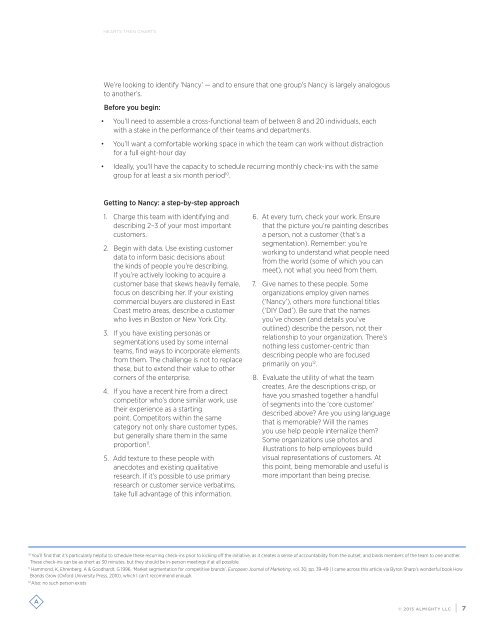Hearts then Charts
Almighty_HeartThenCharts_2015
Almighty_HeartThenCharts_2015
Create successful ePaper yourself
Turn your PDF publications into a flip-book with our unique Google optimized e-Paper software.
HEARTS THEN CHARTS<br />
We’re looking to identify ‘Nancy’ — and to ensure that one group’s Nancy is largely analogous<br />
to another’s.<br />
Before you begin:<br />
• You’ll need to assemble a cross-functional team of between 8 and 20 individuals, each<br />
with a stake in the performance of their teams and departments.<br />
• You’ll want a comfortable working space in which the team can work without distraction<br />
for a full eight-hour day<br />
• Ideally, you’ll have the capacity to schedule recurring monthly check-ins with the same<br />
group for at least a six month period 10 .<br />
Getting to Nancy: a step-by-step approach<br />
1. Charge this team with identifying and<br />
describing 2–3 of your most important<br />
customers.<br />
2. Begin with data. Use existing customer<br />
data to inform basic decisions about<br />
the kinds of people you’re describing.<br />
If you’re actively looking to acquire a<br />
customer base that skews heavily female,<br />
focus on describing her. If your existing<br />
commercial buyers are clustered in East<br />
Coast metro areas, describe a customer<br />
who lives in Boston or New York City.<br />
3. If you have existing personas or<br />
segmentations used by some internal<br />
teams, find ways to incorporate elements<br />
from them. The challenge is not to replace<br />
these, but to extend their value to other<br />
corners of the enterprise.<br />
4. If you have a recent hire from a direct<br />
competitor who’s done similar work, use<br />
their experience as a starting<br />
point. Competitors within the same<br />
category not only share customer types,<br />
but generally share them in the same<br />
proportion 11 .<br />
5. Add texture to these people with<br />
anecdotes and existing qualitative<br />
research. If it’s possible to use primary<br />
research or customer service verbatims,<br />
take full advantage of this information.<br />
6. At every turn, check your work. Ensure<br />
that the picture you’re painting describes<br />
a person, not a customer (that’s a<br />
segmentation). Remember: you’re<br />
working to understand what people need<br />
from the world (some of which you can<br />
meet), not what you need from them.<br />
7. Give names to these people. Some<br />
organizations employ given names<br />
(‘Nancy’), others more functional titles<br />
(‘DIY Dad’). Be sure that the names<br />
you’ve chosen (and details you’ve<br />
outlined) describe the person, not their<br />
relationship to your organization. There’s<br />
nothing less customer-centric than<br />
describing people who are focused<br />
primarily on you 12 .<br />
8. Evaluate the utility of what the team<br />
creates. Are the descriptions crisp, or<br />
have you smashed together a handful<br />
of segments into the ‘core customer’<br />
described above? Are you using language<br />
that is memorable? Will the names<br />
you use help people internalize them?<br />
Some organizations use photos and<br />
illustrations to help employees build<br />
visual representations of customers. At<br />
this point, being memorable and useful is<br />
more important than being precise.<br />
10<br />
You’ll find that it’s particularly helpful to schedule these recurring check-ins prior to kicking off the initiative, as it creates a sense of accountability from the outset, and binds members of the team to one another.<br />
These check-ins can be as short as 30 minutes, but they should be in-person meetings if at all possible.<br />
11<br />
Hammond, K, Ehrenberg, A & Goodhardt, G 1996, ‘Market segmentation for competitive brands’, European Journal of Marketing, vol. 30, pp. 39-49 | I came across this article via Byron Sharp’s wonderful book How<br />
Brands Grow (Oxford University Press, 2010), which I can’t recommend enough.<br />
12<br />
Also: no such person exists<br />
© 2015 ALMIGHTY LLC | 7


